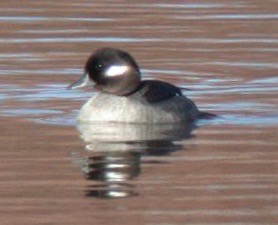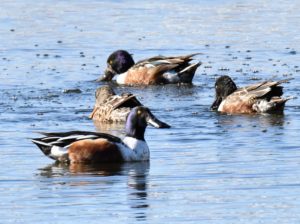This morning’s walk was a bit abbreviated as cold rain mixed with a bit of sleet sent us scurrying back to the cars posthaste. Prior to that though we were able to enjoy a productive couple of hours working on our duck identifications. We did not work on geese or grebe IDs because we saw none. However, the ten duck species we saw now were spectacular. Most of the males were in glorious breeding plumage, though a couple of Mallards and several Northern Shovelers were still a bit betwixt and between. Duck highlights included great looks at American Wigeons, Green-winged Teal, and Hooded Mergansers. And, as we continue to look for new arrivals of those ducks that bred up in northern Canada and will now spend the winter with us, it was gratifying to find a pair of Common Goldeneyes.
The main highlight of the day was a Prairie Falcon, which we saw almost immediately as we first got out of our cars. It was perched initially on top of a light post along Kipling, and then flew rapidly over to the top of another light post along Quincy. This is part of a common foraging strategy for wintering Prairie Falcons. From the top of a pole, or cliff, they can effortlessly survey their surroundings, and then once they have sighted a potential prey item the can swoop down, flying low, fast, and quite powerfully towards their quarry. This behavior, alone, can almost be diagnostic in identifying a Prairie Falcon. Fortunately, we were also able to ascertain that it was a large falcon with obvious pointed wings. Then, once it was on its second perch, we could make out the characteristic malar stripe below its eye. (You might want to check out the introductory pages of your field guide to familiarize yourself with where the malar region is in a bird’s topography.) We could also see the dark ear-patch, and the distinctive white patch between the dark malar stripe and dark ear patch. Again, though, it was the behavior of the bird that offered the best initial clues as to what it was.
So, once again, Harriman delivered. It’s an excellent place for beginning birders as the lake is small enough that it’s possible to make out many of the ducks just with binoculars.
Good birding!
Chuck
Harriman Lake Park, Nov 3, 2018
24 species
Northern Shoveler 190
Gadwall 8
American Wigeon 50
Mallard 35
Green-winged Teal 17
Lesser Scaup 9
Bufflehead 30
Common Goldeneye 2
Hooded Merganser 14
Ruddy Duck 9
American Coot 11
Ring-billed Gull 3
Red-tailed Hawk 2
Northern Flicker 5
Prairie Falcon 1
Blue Jay 3
Black-billed Magpie 1
American Crow 5
Black-capped Chickadee 1
American Robin 1
European Starling 3
House Finch 5
American Tree Sparrow 2
Red-winged Blackbird 28





Comments
Write Comment